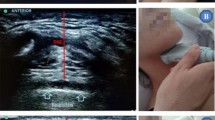Abstract
Objective
To evaluate the feasibility of sonography as a tool to predict difficult airway in children less than 2 y of age.
Methods
Airway ultrasound was performed in 90 children below the age of 2 y to measure airway dimensions preoperatively. Hyomental distance ratio in predicting difficult laryngoscopy was recorded as the primary outcome. Secondary outcomes included tongue thickness/oral cavity thickness ratio and tongue thickness/thyromental distance ratio in predicting difficult laryngoscopy and difficult intubation, time taken for intubation, and any complications. The sensitivity, specificity, positive predictive value, and negative predictive value with 95% CI of all the parameters were recorded.
Results
Six out of 90 (6.7%) patients had difficult laryngoscopy. HMDR was significantly different between children with easy and difficult laryngoscopy (1.15 ± 0.11 vs. 1.03 ± 0.016, p = 0.001). The optimal cutoff points for HMDR, TT/OCT, and TT/TMD to predict difficult laryngoscopy (CL grade III, IV) were > 1.055 (sensitivity 100%, specificity 86.9%), 0.755 (sensitivity 100%, specificity 57%), and 0.445 (sensitivity 53.5%, specificity 66.7%), respectively, the AUC being highest for HMDR (0.959). The cutoff value of ≥ 1.055 of HMDR to predict difficult laryngoscopy had the highest AUC of 0.959, p < 0.001. Fifty-two children had IDS = 0, while 38 had IDS between 1 and 4. None of the patients had IDS > 5.
Conclusions
Ultrasound-guided airway assessment is a feasible option in children less than 2 y. Hyomental distance ratio can form a useful tool for predicting difficult airway in this age group.
Trial Registration
The trial has been registered in Clinical trial Registry of India (CTRI/2019/05/019014) before enrollment of the first patient.


Similar content being viewed by others
References
Fiadjoe JE, Nishisaki A, Jagannathan N, et al. Airway management complications in children with difficult tracheal intubation from the Pediatric Difficult Intubation (PeDI) registry: A prospective Cohort analysis. Lancet Respir Med. 2016;4:37–8.
Rose DK, Cohen MM. The airway: problems and predictions in 18,500 patients. Can J Anaesth. 1994;41:372–83.
Gupta S, Sharma R, Jain D. Airway assessment: predictors of difficult airway. Indian J Anaesth. 2005;49:257–62.
Starface S, Engelhardt T, Teoh WH, Kristensen MS. Essential ultrasound techniques of the pediatric airway. Pediatr Anesth. 2016;26:122–31.
Andruszkiewicz P, Wojtczak J, Sobczyk D, Stach O, Kowalik I. Effectiveness and validity of sonographic upper airway evaluation to predict difficult laryngoscopy. J Ultrasound Med. 2016;35:2243–52.
Adhikari S, Zeger W, Schmier C, et al. Pilot study to determine the utility of point-of-are ultrasound in the assessment of difficult laryngoscopy. Acad Emerg Med. 2011;18:754–8.
Cormack RS, Lehane J. Difficult tracheal intubation in obstetrics Anesthesia. 1984;39:1105–11.
Adnet F, Borron SW, Racine SX, et al. The intubation difficulty scale (IDS). Proposal and Evaluation of a new score characterizing the complexity of endotracheal intubation. Anesthesiology. 1997;87:1290–7.
Huh J, Shin HY, Kim SH, Yoon TK, Kim DK. Diagnostic predictor of difficult laryngoscopy: The hyomental distance ratio. Anaesth Analg. 2009;108:544–8.
Sutthiprapaporn P, Tanimoto K, Ohtsuka M, Nagasaki T, Iida Y, Katsumata A. Positional changes of oropharyngeal structures due to gravity in the upright and supine positions. Dentomaxillofac Radiol. 2008;37:130–5.
Yao W, Wang B. Can tongue thickness measured by ultrasonography predict difficult intubation? Br J Anaesth. 2017;118:601–9.
Abdallah FW, Yu E, Cholvisudhi P, et al. Is ultrasound a valid and reliable imaging modality for airway evaluation? an observational computed tomographic validation study using submandibular scanning of the mouth and oropharynx. J Ultrasound Med. 2017;36:49–59.
Author information
Authors and Affiliations
Contributions
SK: Data collection; DJ: Concept, study designing, manuscript writing; NB: Manuscript editing; KG: Study designing; AJ: Data collection and final editing. DJ will act as the guarantor for this paper.
Corresponding author
Ethics declarations
Ethical Approval
Ethical approval for this study was obtained from the Institute's Ethics Committee (NK/4666/MD/493).
Conflict of Interest
None.
Additional information
Publisher's Note
Springer Nature remains neutral with regard to jurisdictional claims in published maps and institutional affiliations.
Rights and permissions
About this article
Cite this article
Kahlon, S., Jain, D., Bhardwaj, N. et al. Ultrasound Evaluation to Predict Difficult Laryngoscopy in Children below 2 Years. Indian J Pediatr 90, 56–60 (2023). https://doi.org/10.1007/s12098-021-04064-1
Received:
Accepted:
Published:
Issue Date:
DOI: https://doi.org/10.1007/s12098-021-04064-1




